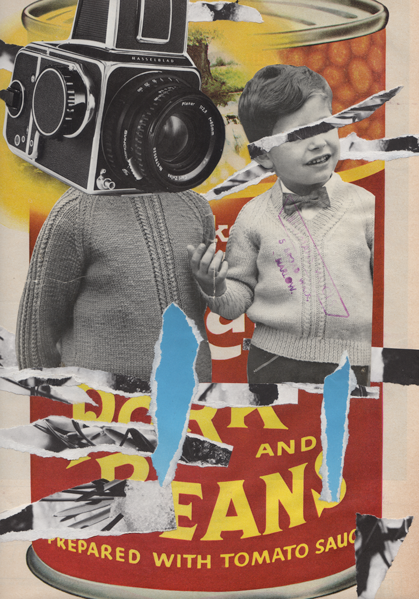 |
Curated by Ric Kasini KadourKolaj Magazine presents an Exhibition-in-Print as a means of exploring critical ideas about collage. We examine work related to a curatorial premise, identify themes and ideas. The purpose is to develop and share an understanding of collage as a medium and a genre. "The Child in Collage" originally appeared in Kolaj #14. Enjoy! |
 |
Ideas about childhood are historically specific and constantly evolving. In Western civilization, prior to the Enlightenment, childhood, as we know it, didn’t exist, and outside of infancy, children were seen as little adults. Beginning in the 17th century and continuing to the present day, philosophers like John Locke, Jean-Jacques Rousseau, and Joshua Reynolds, and later psychologists like Sigmund Freud and Jean Piaget contributed to a theoretical understanding of childhood. Once childhood became a thing, people attempted to shape the experience of children. The church sought to educate children. Social reformers fought to protect children from harm. Over the centuries, childhood developed as a period of innocence, learning, and play; a time of life free of worry, pain, labour, and sexuality. But because every human being experiences it themselves, notions of childhood are often informed by strongly held personal convictions as well as nostalgic notions informed by our own experience and romantic notions of what we perceive as lacking in our own childhoods. These convictions are most often expressed by how one chooses to parent their own children and in one’s opinions of how other children are cared for, either by their parents or the state. |
These complex ideas about childhood are expressed in art in a variety of ways. In Renaissance painting, the portrayals of children are limited to the baby Jesus and portraits of young nobles. The rare exception are paintings like Giovanni Francesco Caroto’s 15th century Boy with a Drawing or Domenico Ghirlandaio’s Old Man and His Grandson. These are rare examples of children doing things we recognize as childhood: scribbling on a piece of paper or a tender moment between family members. Two hundred years later, we begin to see portrayals of childhood. Eighteenth century French painter Jean Baptiste Greuze painted children holding animals and, in a particularly moralistic series, being spoiled. Starting in the Romantic Period, we begin to see children playing and included in social life, but as Modernism took hold, the child became a symbol, a source of meaning in art. Today, George Bellows’ Forty-Two Kids (1907), a painting of boys skinny dipping in New York’s East River, is seen as portrait of youthful frivolity and freedom. At the time, critics denigrated the portrayal of poor immigrant boys by calling them maggots. |
As the 20th century progressed, the portrayal of children in art is almost always loaded with deeper, political meaning that plays with our ideas about childhood. Joel-Peter Witkin uses children to amplify his horrific portrayal of deformities. In Yoshitomo Nara’s sculptures and drawings, cartoonish, soft-pastel hued children are portrayed with weapons and violent intentions that violate their cute, vulnerable appearance. Photographers Mary Ellen Mark and Sally Mann use children to challenge taboos. By contrast, Norman Rockwell’s earnest portrayals of mid-century American life are often held up as symbols of national innocence. With this art history in mind, we examine a number of examples of the portrayal of the child in collage. Because of the nature of the medium, the portrayal of the child in collage is a dialogue between the artist and their source material. In viewing these collages, we must also be aware of our own differing cultural ideas about children. These factors come together to make for a rich and edifying exploration of visual language. |
Claudia Sochting
|
THE CHILD IN CHILDHOOD
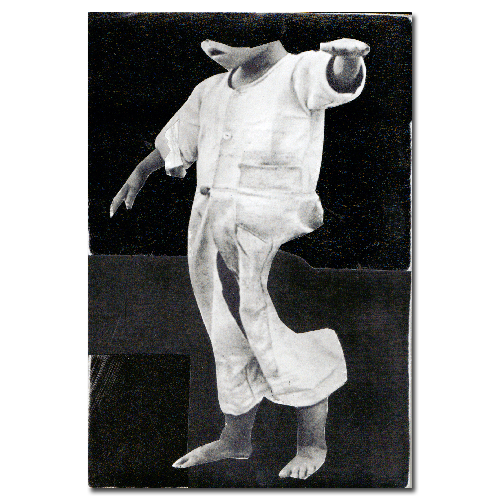
Balanceby Kerstin Stephan
Balance is a rare example of the portrayal of a child in collage acting like a child. It shows a toddler struggling to stay upright. The rough cutting of the child’s hands, the removal of his face and part of his leg reminds the viewer the child is incomplete. Minimalist collages like this often excel at making simple points, but in this case, its rawness opens it to emotional complexity. The non-representational elements—the pieces of black in the background—act as a compositional force that not only supports the image of the child, but suggests unseen forces are supporting the child’s ability to stand upright. The experience of being off-balance often feels like there are unseen forces pushing us down or keeping us from falling. For a child who has not experienced the natural state of balance, these forces must feel unreal. Jork, Germany collagist Kerstin Stephan wrote, “I love to do collage because I can play with this medium like a child with LEGO. I can play with my cutout material for hours. In this creative process I get a prickle in my belly.” Perhaps for the artist, the unreal, unseen force of compositional completion can feel like a child achieving balance for the first time. |
THE LIVES OF CHILDREN
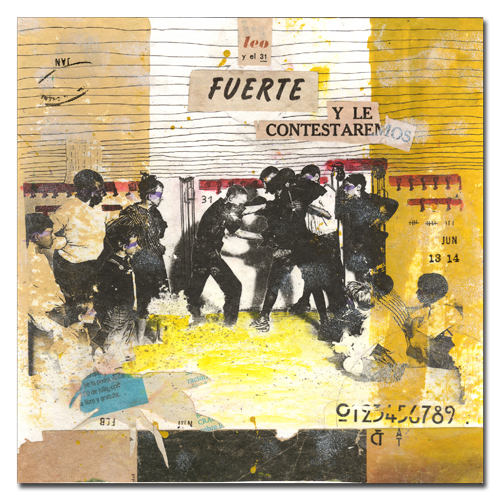
Leo Fuerte by Mathieu Bories
On 12 April 2015, Danielle and Alexander Meitiv of Silver Spring, Maryland dropped their 10-year-old son and 6-year-old daughter off at a park and told them to walk home two hours later. A stranger saw the children playing alone and reported it to the police who came, took the children into custody, and turned them over to Child Protective Services. Many, many words have been written about the overprotection and over-parenting of children. This, along with a bevy of technology and a slew of organized activities for children, has resulted in a wholesale reorganization of childhood. Children live their lives in heavily monitored and often indoor spaces.
Collage and stencil artist Mathieu Bories, who goes by Mateo, uses images of children in a manner that evokes nostalgia for how childhood used to be. In his collages, children play, explore, and fight with each other. They experience joy and sadness. Bories’ subject is less a comment on the state of contemporary parenting but an acknowledgement that we (as a society) used to live differently. His aim is to show the loss of romanticism in contemporary society. |
PORTRAITS OF CHILDHOOD
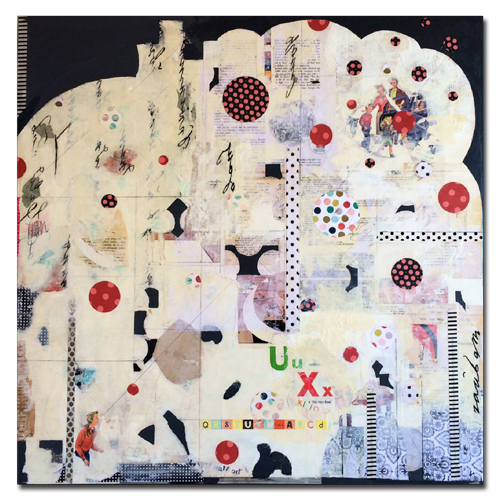
The Happy Child by Angela Holland
A retired educator and family therapist, Angela Holland has years of experience working with children. In her collage work, Holland typically works abstractly, “relishing the freedom of nonverbal expression”, and relying on play and intuition to develop her images. “What delights me is the play of opposing feelings and forces,” she wrote. The Happy Child reads like a map of childhood. It starts in the lower left with a content, young woman looking at a cheerful family getting into a car. The images are the wholesome stock of Dick & Jane books. In between these characters is field of abstract shapes and colours: patterned dots, amorphous black shapes, patches of text obscured by white paint, the occasional letter and references to games. Holland’s collage doesn’t explain what a happy childhood is, rather it tries to convey a feeling of it. |
THE SUFFERING CHILD
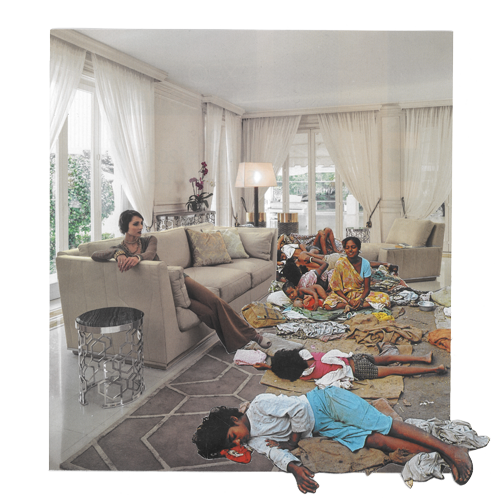
Luxury Homes of Tomorrow by James Springall
We often use representations of children living in the third world to illustrate social, political, and economic strife. For example, we advertise images of hungry children as a way of drawing attention to systemic poverty and famine, even though adults are suffering just as much as children in places facing such problems. Springall’s approach to collage is to “reordering of existing material to create a disturbance of what is, to offer an encounter with otherness.” Luxury Homes of Tomorrow is a critique of wealth in the face of poverty. A well-dressed white woman sits comfortably on a couch while South Asian children sleep on cardboard around her feet. The implication is that in the future, the wealth of Europe and North America will not be isolated from the poverty of the rest of the world. Suffering children are the representation of poverty. |
THE CHILD AS WITNESS
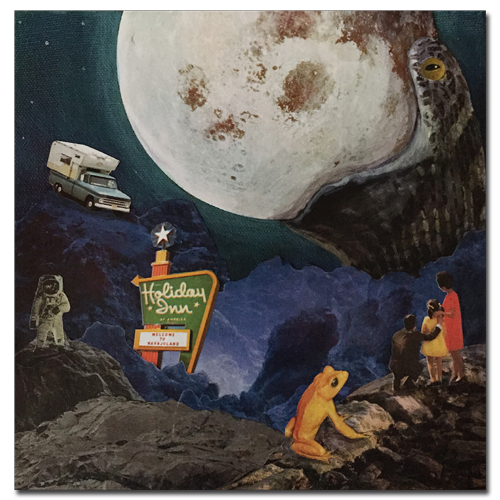
Last Vacation by Angela Tannehill
“When I have an idea for a piece, I try to hold it loosely in my head. I let it fall to the back of my mind while I sift through a mass of images cut from magazines, and put them together in a way that feels right,” wrote Tannehill. “It’s a little like orchestrating a dream; one that requires interpretation after the fact.” The fantasia, Last Vacation, takes place in a dreamy extraterrestrial landscape. A giant snake swallows the moon. An astronaut explores the planet’s surface. A camper-carrying pickup truck crests a ledge and drives towards a retro Holiday Inn. And a giant golden mantella frog watches a nuclear family taking in the scene. The title gives the work an apocalyptic tone and the presence of the child, being shown this scene by her parents, gives the work an elevated sense of importance. A parent’s job is to show the world to their children. That both parents are taking a moment to show the girl this scene suggests an important moment is occurring. Last Vacation is a surrealist work and, as such, its meaning is left to the Daliesque ponderings of the viewer. |
TEACHING VS. PROTECTING
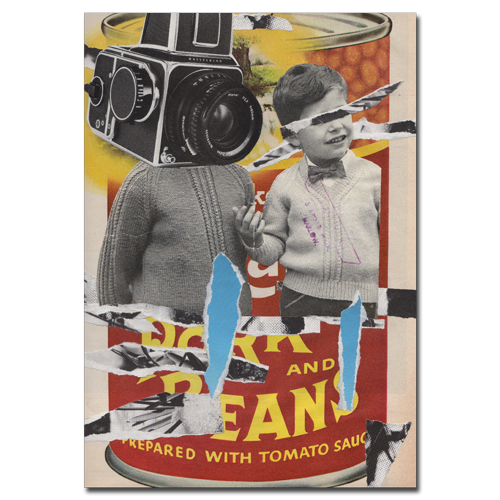
Summer Canned by Peter Evans
A fan of urban decay, Evans’ collages often recreate the layers of torn posters seen on city walls. In Summer Canned, these layers form a story about two boys. One boy’s eyes are covered. He is blind, perhaps sheltered, to the world he sees while the other is portrayed as having a camera for a head, one who takes in everything he is exposed to. Summer Canned contrasts different types of children but also competing ideas about childhood. On the one hand, we want children to learn as much as they can about the world, but on the other we are constantly protecting them from aspects of the world we’d prefer they learn about later in life. This collage trades on that tension. |
COMING OF AGE
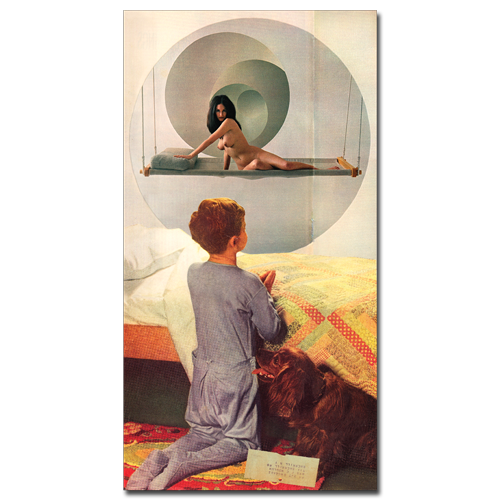
If I Die Before I Wake by Kieran Madden
Madden’s analogue collages use humour to make social commentary. If I Die Before I Wake contrasts images of a wholesome youth saying nightly prayers with the often raunchy thoughts of late adolescent boys. In presenting these contrasting images, Madden challenges Romantic notions of children that date back to Jean-Jacques Rousseau’s construction of childhood in the 18th century. The conventional narrative presupposes that children lose their innocence because they are subjected to an impure world. Madden’s collage suggests that coming of age is a natural evolution, that adult thinking, in this case erotic thoughts, occurs regardless of the moral training the child receives. |
THE END OF CHILDHOOD
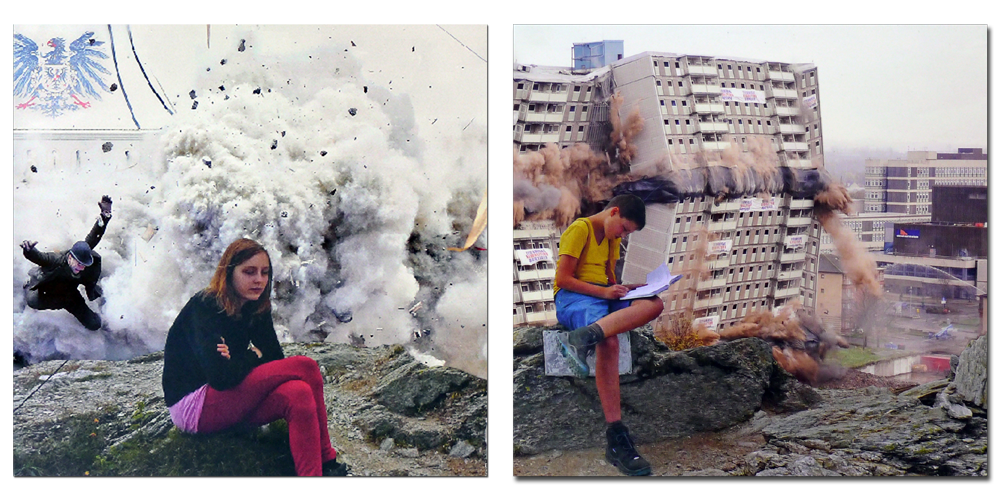
Bajazzo-Boy and Girl by Claudia Söchting
Claudia Söchting makes collages of two or three fragments that show ironic or absurd human situations. The diptych Bajazzo captures perfectly the end of childhood. “Bajazzo” is a German word for clown, but the word has a deeper cultural context. Bajazzo, for example, is also the German name of Ruggero Leoncavallo’s opera Pagliacci and in one regional dialect is slang for penis. A girl and a boy sit uncomfortably in front of an explosion. This combination of explosions, clowns, and the awkward seated position of the children perfectly represents the emotionally complicated transition between childhood and adult life. |
THE CHILD AS ADULT
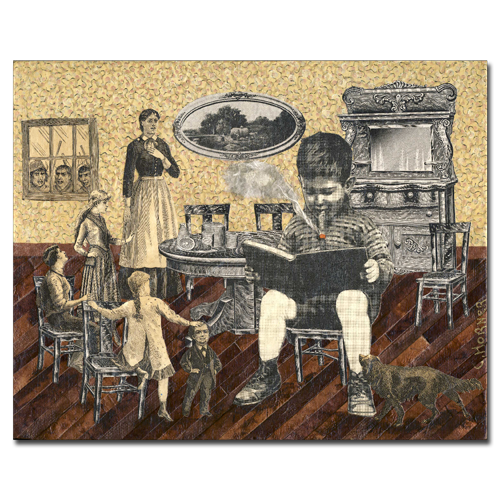
Tommy Could Read Quite Well by Cathy Horner
Cathy Horner uses vintage ephemera to “stir imaginations, but also to encourage a sort of sentimental nostalgia.” The main character in Tommy Could Read Quite Well is shown sitting at the table, reading, while smoking a cigar. The other people of the house sit around holding hands. A group of men gaze in through the window. There are other people in the house who are older than Tommy, but clearly he is more important. He is, literally, the big man of the house. The playfulness of this work comes from the distorted scales at work in the piece, something to which collage is uniquely suited. |
Thank you for viewing "The Child in Collage"Kolaj presents Exhibitions-in-Print as a means of exploring critical ideas about collage by examining work related to a curatorial premise. The purpose is to develop and share an understanding of collage as a medium and a genre. "The Child in Collage" originally appeared in Kolaj #14. About Kolaj InstituteThe mission of Kolaj Institute is to support artists, curators, and writers who seek to study, document, & disseminate ideas that deepen our understanding of collage as a medium, a genre, a community, and a 21st century movement. We operate a number of initiatives meant to bring together community, investigate critical issues, and raise collage’s standing in the art world. ABOUT | PROGRAMS | PUBLICATIONS | NEWS | SUPPORT About Kolaj MagazineKolaj Magazine is a quarterly, printed, art magazine reviewing and surveying contemporary collage with an international perspective. We are interested in collage as a medium, a genre, a community, and a 21st century art movement. WEBSITE | SUBSCRIBE | PRINT MAGAZINE | | SHOP |
